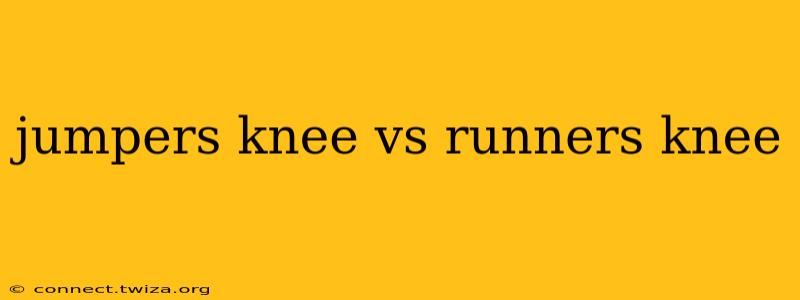Both jumper's knee and runner's knee are common knee pain conditions, often causing confusion due to their similar symptoms. However, while they share some similarities, understanding the key differences is crucial for accurate diagnosis and effective treatment. This article will delve into the specifics of each condition, highlighting their causes, symptoms, and treatment options.
What is Jumper's Knee (Patellar Tendinitis)?
Jumper's knee, also known as patellar tendinitis, is an overuse injury affecting the tendon that connects the kneecap (patella) to the shinbone (tibia). This tendon plays a vital role in extending the knee, making it crucial for activities involving jumping, such as basketball, volleyball, and tennis. The repetitive stress of jumping and landing places significant strain on the patellar tendon, leading to inflammation and pain.
Symptoms of Jumper's Knee
- Pain below the kneecap: This is the hallmark symptom, often worsening after activity and improving with rest.
- Stiffness: The knee may feel stiff, especially in the morning or after periods of inactivity.
- Swelling: Although less common than pain, some swelling may be present.
- Tenderness to the touch: The area below the kneecap may be sensitive to palpation.
- Weakness: Weakness in the knee extensor muscles can also be experienced.
What is Runner's Knee (Patellofemoral Pain Syndrome)?
Runner's knee, or patellofemoral pain syndrome (PFPS), is a broader term encompassing various conditions causing pain around the kneecap. Unlike jumper's knee, which primarily affects the tendon, runner's knee involves pain and discomfort where the kneecap articulates with the thigh bone (femur). This can result from various factors, including muscle imbalances, improper running form, and overuse.
Symptoms of Runner's Knee
- Pain around the kneecap: The pain is often diffuse, meaning it's not localized to one specific point but rather around the kneecap.
- Pain during and after running: Symptoms tend to worsen with activities that involve bending or straightening the knee.
- Creaking or grinding: Some individuals may experience a creaking or grinding sensation in the knee.
- Swelling: Swelling is possible, but not always present.
- Pain going up or down stairs: Activities requiring knee flexion and extension often exacerbate pain.
Jumper's Knee vs. Runner's Knee: Key Differences Summarized
| Feature | Jumper's Knee (Patellar Tendinitis) | Runner's Knee (Patellofemoral Pain Syndrome) |
|---|---|---|
| Affected Area | Patellar tendon (below the kneecap) | Area around the kneecap (patellofemoral joint) |
| Primary Cause | Repetitive jumping and landing | Overuse, muscle imbalances, biomechanical issues |
| Pain Location | Primarily below the kneecap | Diffuse pain around the kneecap |
| Common Activities | Jumping sports (basketball, volleyball, etc.) | Running, cycling, squatting, stair climbing |
How are Jumper's Knee and Runner's Knee Diagnosed?
Diagnosis typically involves a physical examination by a doctor or physical therapist. They will assess your symptoms, examine your range of motion, and palpate the knee to identify areas of tenderness. Imaging tests like X-rays are usually not necessary for initial diagnosis but may be used to rule out other conditions if needed.
What are the Treatment Options for Jumper's Knee and Runner's Knee?
Treatment for both conditions is generally conservative and focuses on rest, ice, compression, and elevation (RICE). Other treatments may include:
- Physical therapy: This involves exercises to strengthen the muscles around the knee, improve flexibility, and correct biomechanical issues.
- Medication: Over-the-counter pain relievers like ibuprofen or naproxen can help manage pain and inflammation. In some cases, your doctor might prescribe stronger pain medication.
- Bracing or taping: Supports can help stabilize the knee and reduce stress on the affected area.
- Injections: Corticosteroid injections can provide temporary pain relief but are not a long-term solution.
- Surgery: Surgery is rarely needed but may be considered in severe cases that haven't responded to conservative treatment.
How Can I Prevent Jumper's Knee and Runner's Knee?
Prevention is key! Here are some tips to reduce your risk:
- Warm-up properly before activity: This prepares your muscles and tendons for exercise.
- Gradually increase activity levels: Avoid sudden increases in intensity or duration.
- Use proper technique: Maintaining correct form during activities is crucial.
- Strengthen your leg muscles: Strong leg muscles provide better support and stability to the knee.
- Stretch regularly: Stretching improves flexibility and reduces muscle tightness.
- Choose appropriate footwear: Proper footwear provides cushioning and support.
- Rest and recover: Allow your body adequate time to rest and recover between workouts.
This information is for general knowledge and does not constitute medical advice. Always consult with a healthcare professional for diagnosis and treatment of any knee pain. They can accurately assess your condition and recommend the most appropriate course of action.
